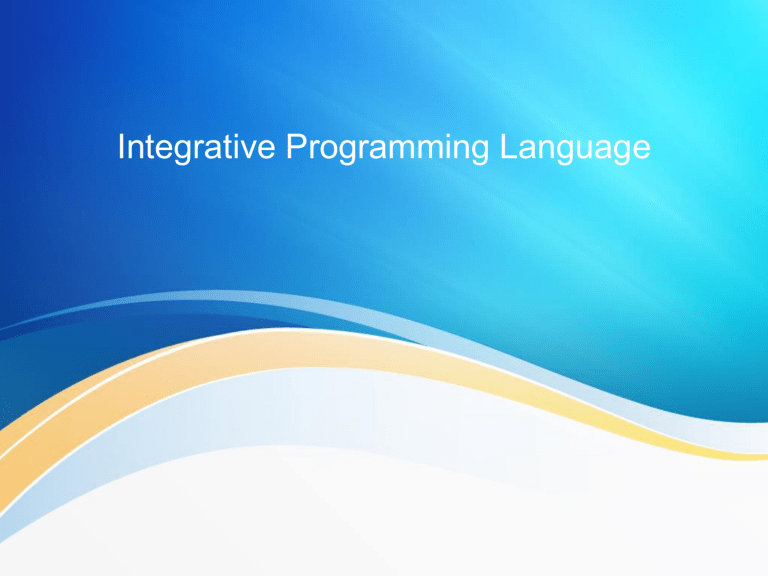
Integrative Programming Language • • • • What is Program? What is Programming What is Programmer? Used of Program? • Algorithm • Pseudocode • Flowcharting Logic formulation and problem-solving are the fundamentals of programming. It requires an intricate process of critical and analytical thinking, combined with precision and keenness to details. The planning stage is very important because it serves as the backbone of any program. A good programmer is a good planner. The most popular langauges • • • • • • • • • • • • C Java C++ PHP JavaScript Python C# Perl SQL Ruby Shell Visual Basic Kinds of Programming Languages • Machine Language • Assembly Language • High Level Language - Third Generation Langauge (BASIC, FORTRAN, Pascal, COBOL, C, C++, C# and Java) - Fourth Generation Language (Web Development and Report Generation, Database, GUI and SQL) - Fifth Generation Langauge - AI - Natural Langauge - Human Languages Procedure-Oriented High Level Languages • Design and write every sigle step to do a certain task or solve a paarticular problem. The written program is sequential and its execution is on a line-by-line basis • Ex: Ada, Algol, BASIC, C, C++, C#, COBOL, Common Lisp, Fortran, Pascal Object-Oriented / Event-Driven Languages • focusing on objects and events; also event-driven such that when a paarticular event occurs, a program is executed • ex: Visual Basic / Net, Java, C#, C++, PHP5, Perl, Ruby, Smalltalk Data Handling in Programming Data Types • Numeric (Integer / Float or Double) • Alphanumeric (Number / Character / String) • Date and Time • Logical Data Variables Constants • • • • Operators Arithmetic Relational Logical Visual Basic • High level programming language • created by Microsoft • uses graphical environment called Integrated Development Environment (IDE) • capable of developing window-based applications and games • event driven langauge • made up of many subprograms, each with its own codes that can run independently and at the same time can be linked together Commonly Used Terms • Application - collection of objects tat work together to accomplish certain task/s for its users. EX: MS Word, PhotoShop • Project - the term used in VB pertaining to applications. EX: Payroll System, Quiz Bee Scoring • Object - a piece of software that has properties and functions that can be managed or controlled Ex: window, dialog box • Property - characteristic of an object EX: color, size • Methods - functions of an object that can be manipulated EX: opening, resizing • Object-oriented environment - a place wherein application is created using objects and combining them to produce an output EX: VB environment • Event - an action that happens EX: Clicking • Event-driven - an operation is executed as the result of some kind of event • Form - the first object you will see on the screen; where all the controls are placed; where you will enter data and see the results • Controls - the objects you put on the form EX: Label, Command button • Code - computer instructions written by the programmer. These will inidcate what action or result will be when an event occurs • Script - other name for code • Design Time - a time when you visually design and layout the forms and the objects on it • Run Time - a time when the program is executed VB IDE • Working area. It is a graphical environment which allows you to easily design, run, and debug the program you are creating Parts and Functions • Title bar - shows the title • Menu bar - consists of different menus that hold different functions • Tool bar - contains several buttons for commonly used commands • Project Window - contains the project files and groups them by type View Code button - opens the window for writing visual basic codes View object button - displays the form Toggle folders button - shows or hides the content of the forms folder Project • A collection of objects that where placed together to create an application that will be useful to users such as grading system, payroll system or games • Toolbox - contains different controls for objects that can be placed in the form • Label - displays text that cannot be edited by the user of the program • Frame - groups other controls • checkbox - provides the options check or uncheck • combobox - provides a list of choices for the user to select from • HScroll bar - creates a horizontal scrollbar • Timer - counts time intervals for a specific action to take place • DirListbox - Accesses directories • Shape - draws rectangles, squares, ovals, circles, etc • Image - shows image • ole - relates with other applications • PictureBox - displays images • Textbox - Accepts input given by the user displays text • Commandbutton - creates button that when clicked will perform a specific task • optionbutton - creates buttons wherein one button can only be selected. Also called radio button • List box - gives a list of items to choose from • VScrollbar - shows a vertical scrollbar • DriveListBox - accesses the disk drives • FileListbox - accesses files inside a directory • line - draws a line • Data - connects the program to a database Pointer • is not a control. It is used to manage the controls such as move the command button or select the label. • Form - the working area where the different controls are displayed • Properties window - displays attributes of he currently selected component • Form layout window - shows the form’s position on the screen when the program is executed.
